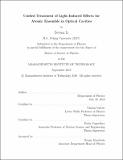Unified treatment of light-induced effects for atomic ensemble in optical cavities
Author(s)
Li, Zeyang(Physicist)Massachusetts Institute of Technology.
Download1196184880-MIT.pdf (6.619Mb)
Other Contributors
Massachusetts Institute of Technology. Department of Physics.
Advisor
Vladan Vuletic and Paola Cappellaro.
Terms of use
Metadata
Show full item recordAbstract
In this thesis, I describe how to realistically treat atomic ensembles inside an optical cavity and use these atoms to sense quantum signals. In particular, the limitation of using uncorrelated atoms for metrology is set by the standard quantum limit (SQL) which scales as 1 [square root of N where N is the atom number. The presense of the optical cavity is essential to generate quantum entanglement and therefore to enhance sensing and quantum metrology in an ensemble of particles. I first discuss how an ensemble of 171Yb atoms interact with light in a cavity. Precedents in this direction focused either on the measurement aspect or the lightinduced atomic interaction aspect of photons, while in this thesis I propose a unified way to theoretically consider both. I then consider the best way to extract information about the atomic system using the light field. The standard method is by generating a spin squeezed state to minimize the variance along a particular axis of interest. We perform experiments to show that by loading N0 = 800 atoms into the optical cavity, we can reduce the quantum projection noise by 10dB below SQL while keeping the state almost unitary, which is important for sensing under realistic conditions. Some other methods to either generate spin squeezed states or detect signals are proposed. While these cases are considered theoretically where no decoherence occurs, I also analyzed experimental requirements of the method to go beyond the state of the art. Altogether, these developments pave the way for using quantum engineered 171Yb atom ensembles to detect and sense very precise signals beyond SQL.
Description
This electronic version was submitted by the student author. The certified thesis is available in the Institute Archives and Special Collections. Thesis: S.M., Massachusetts Institute of Technology, Department of Physics, September, 2019 Cataloged from the official PDF of thesis. Includes bibliographical references (pages 87-94).
Date issued
2019Department
Massachusetts Institute of Technology. Department of PhysicsPublisher
Massachusetts Institute of Technology
Keywords
Physics.